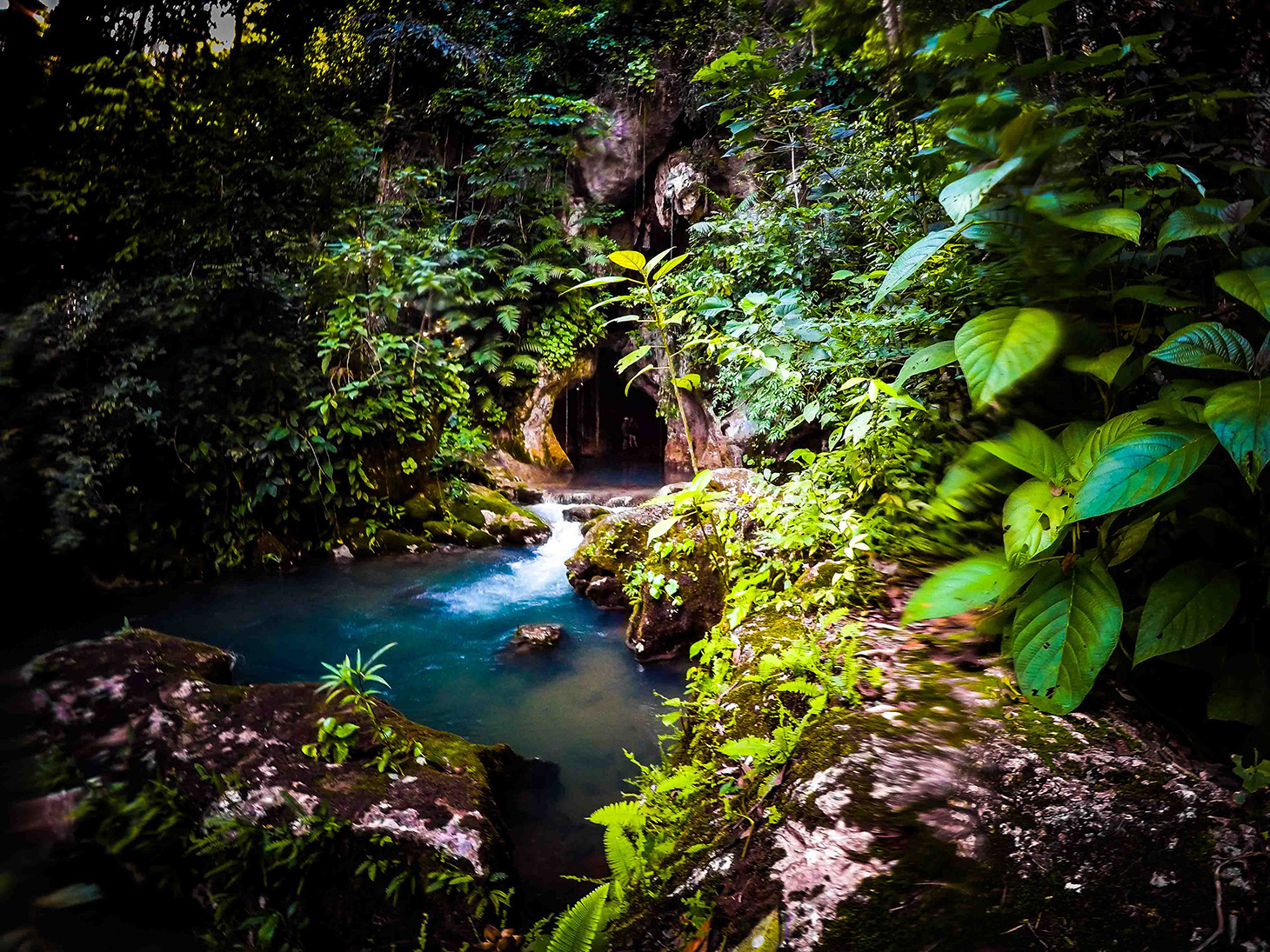It is totally dark, save for the weak, withering flame at the end of his torch.
Onto the cold clay, he sets down a cloth bag and removes several pieces of pottery. One is the sun, and he sets it at the far end of the chasm. Another is the moon, which he sets at the other end. He sets another between them, and this one is the Earth.
Now, he takes kindling from the bag, arranges it in a small pile, touches it with his torch, and soon flame-flung shadows prance about the cave’s walls, and his chants begin.
This, surely, will please the gods, and the rains will return.
No one knew why the gods had stopped sending the rains, but without them, the land had dried, the crops failed, and the people were hungry.
Only the shamans could communicate with the gods, and the only way to reach the gods was down, deep underground, in the caves. So the Mayans who once lived here, in what is now the verdant countryside of western Belize, sent their shamans underground to perform rituals, to plead with the gods, to bring back the rains.
And today, descendants of those who once swam and slipped and crawled about those dank cavities to make their desperate pleas for rain now follow in their ancestors’ footsteps, bringing visitors into the dark for a rare rendezvous with a desperate past.
One such descendant is our guide Luis, whom we meet in the streets of San Ignacio, the closest contemporary civilization to the cave known as Actun Tunichil Muknal—the Cave of the Crystal Sepulchre. We climb into his battered SUV and head out of town.
Luis has been guiding in this part of the world for a long time. He’s one of the best around, but the years seem to have left him a little wistful for less civilized, riskier times of not so long ago.
“All this was sticks and leaves when I was a boy,” he says, as we rattle past car dealerships, cellphone outlets, hostels, and cafés.
So it was easy, during such moments of gentle nostalgia, to sympathize with Luis. But in other moments, filled more with schadenfreude than sentimentality, it wasn’t.
On a small bridge, Luis stops and points to a shallow point downstream. “Just there,” he says, beginning to chortle, “my friend put his car in the river, and it went downstream, with tourists and everything!”
“I thought, where are you taking them?!” his chortles escalating into hoots of laughter. “It was a Landcruiser too. A new Landcruiser! Those were the good old days…”
“Was everyone okay in the end?” I ask.
“Yes,” Luis says, with detectable disappointment, “they were okay in the end.”
We leave the car and walk into the forest, hauling ourselves across the river on ropes wherever it floods the path, and soon we’re at the cave’s entrance, an urn-shaped crack in the earth, a dark hole from which turquoise water spills out onto the forest floor.
We wade in, and before long, all daylight is lost and sensory input reduced to the slip-slap of wet rock, the echoing voices of other spelunkers, and a ballet of headlamp lights that cast dancing illuminations about the dripping ceilings and walls, and occasionally catch the tiny fish that flicker and flash about our legs.
We fold ourselves around boulders and squeeze through gaps. “There’s a fair bit of current in here,” I say to Luis.
“The water was a lot more pushy last week,” he says, with rising excitement.
“The water came in fast, and some people got trapped up there on that rock,” he says, pointing with glee. “It took all night to get them out.”
“Was everyone okay in the end?” I ask.
“Yes,” Luis says, defeated again. “They were okay in the end.”
We haul ourselves onto a wet ledge, remove our shoes, and walk over smoothed orange ground into a cathedral of a chasm, monumental walls leaning in and towering over a hollow, damp nave.
The Mayans believed that Chaac, a fanged, axe-wielding human-animal hybrid with the skin of a fish and the nose of an elephant, was the god responsible for allowing the passage of water from the clouds to the Earth. When the clouds were full and the time was right, Chaac would swing his axe, creating lightning and thunder, and releasing the rains.
But something clearly wasn’t working. So the shamans made sacred places in the caves, and set out urns representing the sun and the moon and the Earth.
“Look,” Luis says, casting his headlight across the cave. “Pottery.”
An assortment of urns lie strewn across the floor. Others are set on ledges and pedestals. Most are cracked and broken, but incredibly, a few remain intact. They have been dated to around 250 AD.
“The urns for the sun and the moon are the same size,” Luis says, “because they didn’t know.”
Then they would light fires, take medicine, make sculptures, and reach out to the gods. But these rituals didn’t work. The droughts continued. More had to be done.
We leave the scattered, shattered pottery and move deeper into the cave.
“Look,” Luis says, casting his headlight down over the cave’s floor, “bones.”
And sure enough, cast into the ground and coated by the calcite that gives these caverns their alien architecture, are the unmistakable outlines of ribs and tibias, of skulls and scapulas.
The bones are human, and it is here, evidently, that more urgent appeals were made.
The human sacrifices in this part of the network happened more than a thousand years ago. As the centuries passed, and the droughts dragged on, desperation grew, and the shamans ventured ever deeper into the caves.
More and more Mayans—men, women, and children—met their ends here in these darkened voids in a variety of upsetting ways. Heads were caved in, backs were broken, blood was let, and infants were left alone to die, bound but very much alive, their cries echoing off the walls.
“Like surround sound,” Luis says, with signature sensitivity.
In one corner lies a near-complete skeleton. It is coated entirely in calcite and glitters ghostly in the beams of our bright, modern lights. Originally dubbed the Crystal Maiden, it is now believed by archeologists to be the remains of a teenage boy. This individual was almost certainly clubbed to death in ever more violent yet futile efforts to appease the gods.
Chaac never would swing his axe, the rains would not return, and civilization disappeared from this part of the world for hundreds and hundreds of years.
“They weren’t okay in the end,” Luis says.
Read more travel stories.









